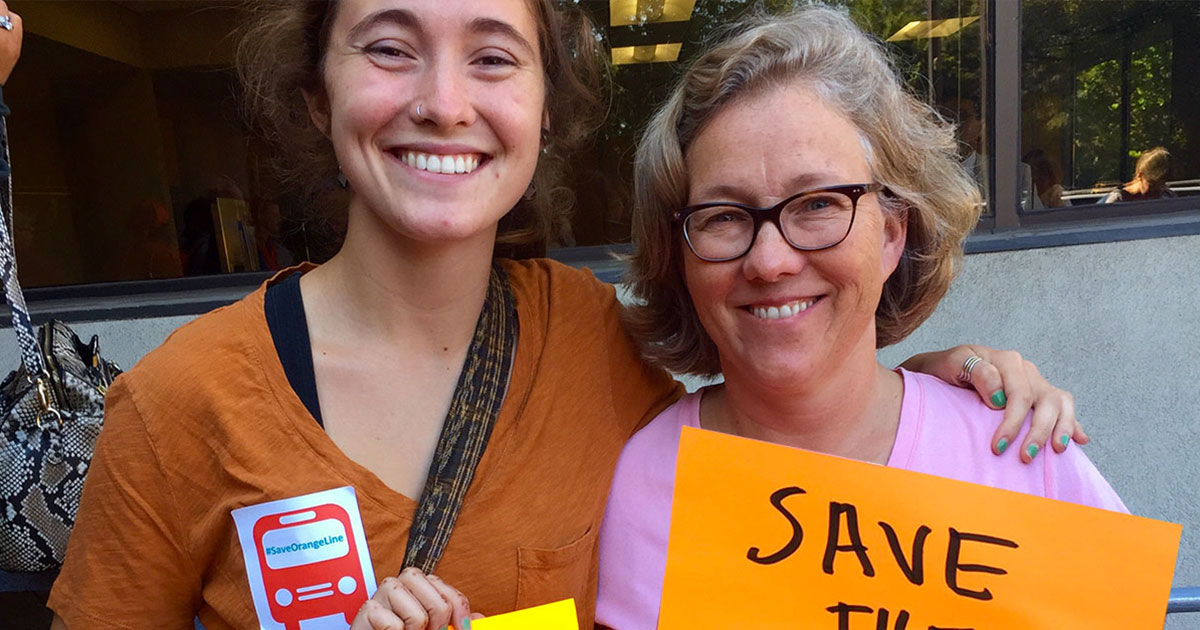Major Milestones for Orange Line and Southwest Light Rail
In the Twin Cities metro, 2018 is coming to a close with big progress for transit riders and supporters. In late November, the Orange Line received all the federal dollars it needed to become fully funded. That same week, officials also broke ground on the Southwest Green Line Extension. Both of these major projects have been in the works for years and are likely to transform how people get around in our cities and suburbs.
Orange Line Now Fully Funded
Riding the bus should feel effortless. If you agree with that statement, then Orange Line bus rapid transit is a game-changer.
The Orange Line will improve people’s access to 198,000 jobs in the busiest commuter corridor in the metro. It will mean nice, new stations along I-35W and a fast, frequent transit option—all-day, seven days a week. That’s a whole new level of consistency and reliability for riders traveling between downtown Minneapolis, Richfield, Bloomington, and Burnsville.
Orange Line plans include replacing what might have been “the worst Metro Transit bus stop of all time” with a new, and desperately needed, Lake Street Station and better bicycling and walking connections to local streets and the Midtown Greenway. Within a ten-minute walk, almost half of all residents are transit dependent and three-fourths are people of color. We’re excited to see this accessible, multimodal station open up new options for people of all abilities and to see the connections it creates for the surrounding neighborhood.
Despite all these positives, the fact that the Orange Line is now fully funded did not come easily. It took persistence from people who believed this project was worth fighting for.
In August 2016, the planned bus rapid transit line hit a big snag here at home, when it almost lost county funding. With the entire project at risk, our advocates and allies rallied to save it. The groundswell of support sent a clear message to regional decision-makers that the Orange Line is truly a must-have for the metro.
Until two weeks ago, federal funding for the Orange Line was also uncertain–especially under the Trump Administration, which in 2017 had proposed ending federal investment in any new transit construction in the US.
Now, with the final $74 million in federal funding confirmed, riders can breathe easy. Construction is underway and the Orange Line has all the resources it needs to move forward. Phew! We can’t wait to ride it with you in 2021!
Southwest Light Rail Breaks Ground
The Southwest Green Line Extension also hit a major milestone in recent weeks. The Federal Transit Administration gave approval for construction to begin, and officials held a ceremonial ground breaking on November 30.
This moment has been a long time coming. For over a decade, our supporters have joined other metro residents and decision-makers in shaping plans for Southwest light rail. Throughout that planning process, the project has been a lightning rod for transit critics and has inspired important debates even among transit supporters. The project timeline has been delayed several times.
Real construction could finally start this winter and then continue over the next three years, creating up to 7,500 construction jobs in the process. The highly anticipated line will likely open in 2023.
When it does, people in St. Louis Park, Hopkins, Minnetonka, and Eden Prairie will have light rail access in their communities for the first time, and new stations will connect residents in Minneapolis. On weekdays, at least 34,000 riders will use the Green Line Extension to get to work and other key destinations. The new extension will connect seamlessly with the Green Line service that runs today between downtown Minneapolis and downtown Saint Paul.
This light rail project also highlights the need for more transit-oriented development and affordable housing in the southwest metro. The Metropolitan Council anticipates that the population along the Southwest extension will grow a whopping 56 percent by 2035. And how we grow as a region really matters. When we’re intentional about combining transformative new transit options with sustainable and community-centered land use, we can ensure that the cities and suburbs of the future are more equitable, more climate-friendly, and more connected than the ones we live in today. Thanks to all for joining in the work to make it happen—and celebrating the big and small wins along the way!

